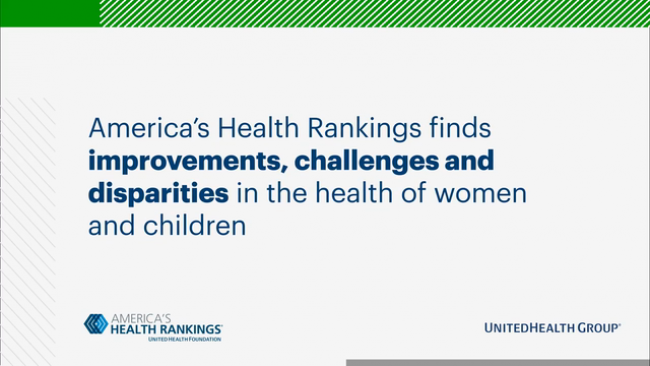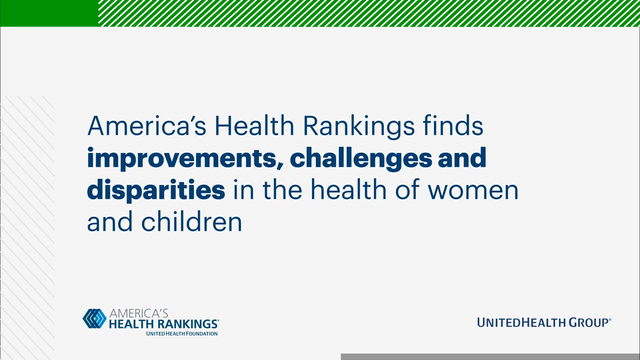New Health Report Identifies Need to Address Mental and Behavioral Health Among Teens and Children in the U.S.
Anxiety among children and teen suicide increased significantly before and during the pandemic, underscoring the urgent need for a continued focus on behavioral health support
The health of women and children impacts the overall health and economic strength of communities across the United States. While measurable progress has been made in recent years to monitor and improve health for women and children, the United Health Foundation’s “America’s Health Rankings 2021 Health of Women and Children Report” highlights improvements, challenges and disparities in health and well-being across all 50 states.
Most notably, behavioral health measures for children highlighted significant challenges before and during the COVID-19 pandemic:
-
Anxiety among children ages 3-17 rose 21% between 2017-2018 and 2019-2020, from 7.5% to 9.1%.
-
Teen suicide increased 26% between 2014-2016 and 2017-2019, from 8.9 to 11.2 deaths per 100,000 adolescents.
-
The teen suicide rate was 4.7 times higher among American Indian/Alaska Native adolescents than Black adolescents.
The report also found increased frequent mental distress in women, increasing levels of obesity among women and lack of physical activity among children. Maternal mortality and maternal morbidity are rising, especially in certain states and among Black mothers.
The report finds progress in some areas including lower rates of teen births, and the prevalence of cigarette smoking among women. Progress remains stagnant in others, such as the number of low birth weight infants.
UnitedHealth Group and the United Health Foundation are working to address health disparities and advance health equity, as described in the 2020 Sustainability Report. But much work remains to achieve more equitable health outcomes. The United Health Foundation encourages the use of America’s Health Rankings reports as a resource for building healthier communities.
‘America’s Health Rankings 2021 Health of Women and Children Report’
The “Health of Women and Children Report” provides a comprehensive look at the health of over 58 million women of reproductive age and over 73 million children, examining overall health across the nation leading up to and during the early part of the COVID-19 pandemic. This year’s report also offers deeper insights into maternal health risks and other urgent public health issues.
While the nation has achieved sustained success over the years in some areas, several areas of concern remain. The public is encouraged to browse the full report. In addition to behavioral health challenges, additional key challenges include:
-
MATERNAL HEALTH
-
Maternal mortality increased 16% nationally in 2018-2019, from 17.4 to 20.1 maternal deaths per 100,000 live births.
-
In 2017-2019, the maternal morbidity rate was 6.6 per 1,000 births, representing 74,255 instances. The definition of this measure is the number of births in which the mother experiences admission to the ICU, a ruptured uterus, a transfusion or an unplanned hysterectomy.
-
Maternal mortality increased 16% or more in three states: Florida (up 70% from 15.8 to 26.8), Georgia (up 23% from 27.7 to 34.0) and Indiana (up 16% from 24.5 to 28.4).
-
-
PHYSICAL ACTIVITY
-
Only 20.6% of children (ages 6-17) in 2019-2020 were physically active for at least 60 minutes each day in the past week, which is the CDC recommendation.
-
Only 21.5% of women in 2019 met federal physical activity guidelines, which depend on age and personal health factors.
-
-
EDUCATIONAL ATTAINMENT
-
Only 1 in 3 (34.3%) fourth grade public school students scored proficient or above on the national reading assessment in 2019. National reading assessments are an important marker in educational development. Later in life, there is a strong connection between education attainment and health. Those without a high school education face the greatest social, economic and health challenges.
-
Reading proficiency varied by state and was nearly twice as high in Massachusetts (45.4%) than in New Mexico (23.7%).
-
How We’re Making an Impact
We encourage public health leaders, lawmakers and nonprofits to use America’s Health Rankings as a resource for building healthier communities. UnitedHealth Group, including the United Health Foundation, UnitedHealthcare and Optum, partners with national and local nonprofit organizations to support emerging strategies to address public health challenges identified by “America’s Health Rankings,” and advance health equity. Following are examples of our recent work (past five years) to address key challenges revealed in this report.
We have donated more than $14.3 million in 13 states to address youth mental health through strategic grant partners such as Children’s Hospital of Wisconsin.
We have provided more than $13.9 million in 17 states to support new and emerging strategies to address maternal health including grant partners such as the Morehouse School of Medicine.
We have created grant partnerships with nonprofits that help children who need opportunities to be physically active and maintain a healthy weight totaling more than $7 million in 35 states, including a national, strategic grant partnership with the Cal Ripken, Sr. Foundation.
The United Health Foundation has contributed $8.3 million to organizations to create programs that work through the school system to improve health – but also to improve school attendance, so children come to school better prepared to learn. One of these grant partnerships includes Family First Health in York, Pennsylvania.
“It is alarming that we are seeing a 21% increase in childhood anxiety, but it is not surprising since that data reflects the early pandemic reality. But just because this is more common does not mean that it is normal or should be dismissed. Please be on the lookout and seek professional support for your children or family members if they continue to struggle with anxiety, mental or physical health concerns.” – Dr. Rhonda Randall, EVP & Chief Medical Officer, UnitedHealthcare Employer and Individual
Data in this year’s report is based on the most recent publicly available data. The majority was collected prior to the pandemic, while data from the 2020 National Survey of Children’s Health captures insights from the early stages of the pandemic. With many measures, the report drills down to expose differences by geography, education level, income level and race/ethnicity. This examination often reveals differences among groups that national or state aggregate data mask.
For more than 30 years, UnitedHealth Group has used findings from America’s Health Rankings reports, along with additional data and insights from the organization’s 330,000 team members, to devise and deliver targeted, meaningful solutions that address America’s health disparities — in health care, insurance, clinical expertise and financial support. UnitedHealth Group partners with national and local organizations, government agencies, experts and lawmakers to further improve and better target these solutions, and help all people live healthier lives.
Explore UnitedHealth Group’s annual Sustainability Report to learn more about our efforts to address health disp.arities and advance health equity.



